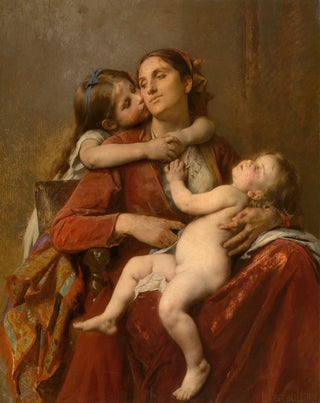Art print | The happiness of mothers - Léon Jean-Basile Perrault


View from behind

Frame (optional)
In the vast panorama of art history, certain works stand out for their ability to capture universal emotions and evoke deeply human stories. "The Happiness of Mothers" by Léon Jean-Basile Perrault is one of those creations that transcend the simple frame of painting to become a true hymn to motherhood. This piece, executed with remarkable delicacy, depicts the tenderness and joy of a mother interacting with her child, inviting the viewer into an immersion in a moment of pure happiness. The scene, bathed in soft light, evokes an atmosphere of serenity and warmth, where every detail seems to tell a story.
Style and uniqueness of the work
Perrault's style is characterized by meticulous attention to detail and a palette of gentle colors that give his works an almost dreamlike quality. In "The Happiness of Mothers," the faces of the characters are rendered with such precision that they seem to vibrate with a life of their own. The expressions, both serene and joyful, convey a sense of fulfillment and unconditional love. The composition, carefully balanced, guides the viewer's gaze across the scene, creating a dynamic that evokes the tenderness of a family bond. The nuances of light and shadow, skillfully mastered, add emotional depth that makes this work a true masterpiece of Romantic art. Every element, from the choice of clothing to the delicate gestures of the characters, contributes to the visual storytelling, making the observation experience both intimate and universal.
The artist and his influence
Léon Jean-Basile Perrault, born in the 19th century, is often recognized for his touching representations of daily life and human relationships. Influenced by the Romantic movement, he was able to capture the deep feelings that animate his subjects, elevating them to the rank of icons of human sensitivity. His artistic training, marked by masters of the era, allowed him to develop a style that combines realism and idealization. Perrault managed to establish himself in the artistic scene of his time, and his work continues to inspire many

Matte finish

View from behind

Frame (optional)
In the vast panorama of art history, certain works stand out for their ability to capture universal emotions and evoke deeply human stories. "The Happiness of Mothers" by Léon Jean-Basile Perrault is one of those creations that transcend the simple frame of painting to become a true hymn to motherhood. This piece, executed with remarkable delicacy, depicts the tenderness and joy of a mother interacting with her child, inviting the viewer into an immersion in a moment of pure happiness. The scene, bathed in soft light, evokes an atmosphere of serenity and warmth, where every detail seems to tell a story.
Style and uniqueness of the work
Perrault's style is characterized by meticulous attention to detail and a palette of gentle colors that give his works an almost dreamlike quality. In "The Happiness of Mothers," the faces of the characters are rendered with such precision that they seem to vibrate with a life of their own. The expressions, both serene and joyful, convey a sense of fulfillment and unconditional love. The composition, carefully balanced, guides the viewer's gaze across the scene, creating a dynamic that evokes the tenderness of a family bond. The nuances of light and shadow, skillfully mastered, add emotional depth that makes this work a true masterpiece of Romantic art. Every element, from the choice of clothing to the delicate gestures of the characters, contributes to the visual storytelling, making the observation experience both intimate and universal.
The artist and his influence
Léon Jean-Basile Perrault, born in the 19th century, is often recognized for his touching representations of daily life and human relationships. Influenced by the Romantic movement, he was able to capture the deep feelings that animate his subjects, elevating them to the rank of icons of human sensitivity. His artistic training, marked by masters of the era, allowed him to develop a style that combines realism and idealization. Perrault managed to establish himself in the artistic scene of his time, and his work continues to inspire many






